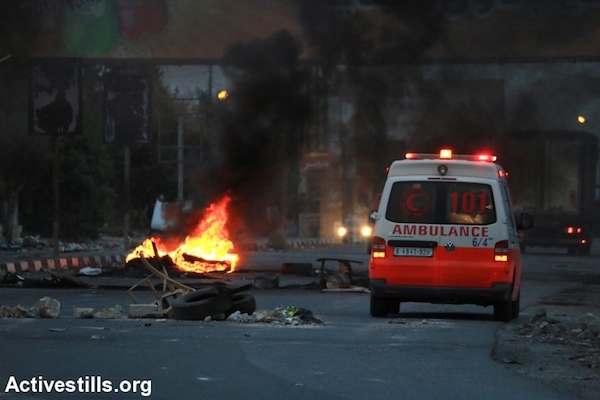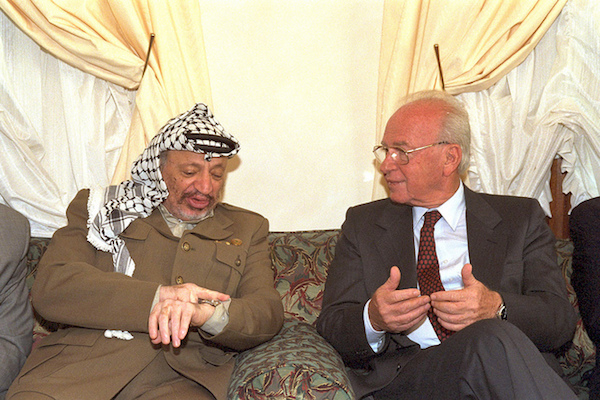Both Israelis and Palestinians need to start thinking far beyond what their leaders are offering them.

Benjamin Netanyahu and Mahmoud Abbas will never make peace. They will never succeed at stopping the violence, and they will never see eye to eye on anything other than the incompatibility of their respective visions.
Don’t get me wrong: both men want peace. Even Benjamin Netanyahu, despite everything you’ve heard, is not a bloodthirsty warmonger who dreams of keeping an entire population under military rule in perpetuity. No. He is a master politician whose worldview dictates that the Jewish people will never be safe and that Muslims in general, but Palestinians in particular, are the greatest threat to it.
That world view is the driving force behind the only two issues in which Netanyahu has ever fully invested himself in his political career: preventing Iranian nuclear proliferation, and ensuring that Israel does not give up strategic military control of the West Bank and Gaza. It’s not that he wants to rule over the Palestinians, it’s just that they happen to live on the land over which he will never agree to cede control.
There will never be a Palestinian leader who agrees to Netanyahu’s terms for peace — terms that preclude any semblance of a sovereign Palestinian state. There will also never be any occupied and subjugated people that does not employ violence, sometimes abhorrent violence, to resist an oppressive military regime that offers them no avenue or hope for equality and dignity.
So if there isn’t going to be peace — and by peace, I mean the two-state paradigm beyond which few people seem able to think these days — then what can be done about the violence? How can we get back to normal?
The answer is two-fold. Firstly, when people talk about addressing the violence at times like these they are generally referring only to Palestinian violence directed at Israelis, not the structural violence of Israel’s occupation and the deadly physical violence it visits on Palestinians. Getting back to “normal” is the goal of Israel and Israel alone.

Secondly, we can fundamentally challenge and reshape the way we think about the Israeli-Palestinian conflict and its resolution. The first step in such a process might be to stop framing the conflict in national terms and instead think of the needs of all the individuals living in this land. National self-determination is very important to most Israelis and Palestinians, but is it more important than human dignity, personal security and basic civil and human rights?
A host of mostly “left-wing” Israeli commentators have exploited the current round of violence to warn of the dangers they say are inherent in a one-state solution. The current wave of violence and stratification is what a one-state solution would look like, Ari Shavit wrote. But this is not what a one-state solution looks like — this is what the current regime of institutionalized segregation, military occupation, and ethnic segregation and disenfranchisement look like.
A real one-state solution would espouse equality, power sharing, accessible mechanisms for addressing inequalities and injustice, guarantees for the protection of minorities and weaker segments of society. A one-state solution would embody an iteration of democracy that serves and protects both Israelis and Palestinians, not a state that belongs only to one ethnic group.
At the same time, let’s not delude ourselves. Granting everyone full equality and rights — including a just resolution to the Palestinian refugee problem — will not guarantee an end to the incessant tides of violence that have tortured both Israelis and Palestinians for the better part of a century. But choosing to stay the course down a zero-sum path, which buys security and freedom for one segment of the population at the expense of another, is a sure-fire recipe for a future of continued violence and suffering.

In two weeks’ time Israelis will mark 20 years since the assassination of Yitzhak Rabin. Instead of lamenting the notion that the prime minister’s murder also killed the peace process, Israelis and Palestinians might be better served taking a different look at Rabin’s legacy and the lessons it carries.
The Oslo peace process followed a period of violence, the First Intifada. Rabin’s decision to take a chance on peace and diplomacy was not a given at the time. After failing to crush the First Intifada by ordering Israeli troops to break Palestinians’ bones, Rabin the former army general was beginning to see the limitations of military might. Brute force and oppression weren’t working, so he decided to try something else.
Twenty years on, maybe the legacy of Rabin is not that the two-state solution is “the only game in town,” as so many have come to refer to it over the years. The Oslo framework and the two-state game has been tried, and it has failed. Maybe, on the 20th anniversary of his death, we should learn from Rabin that when one strategy isn’t achieving the desired result, the answer is to change your approach. Perhaps the only question then is what is the desired result.


